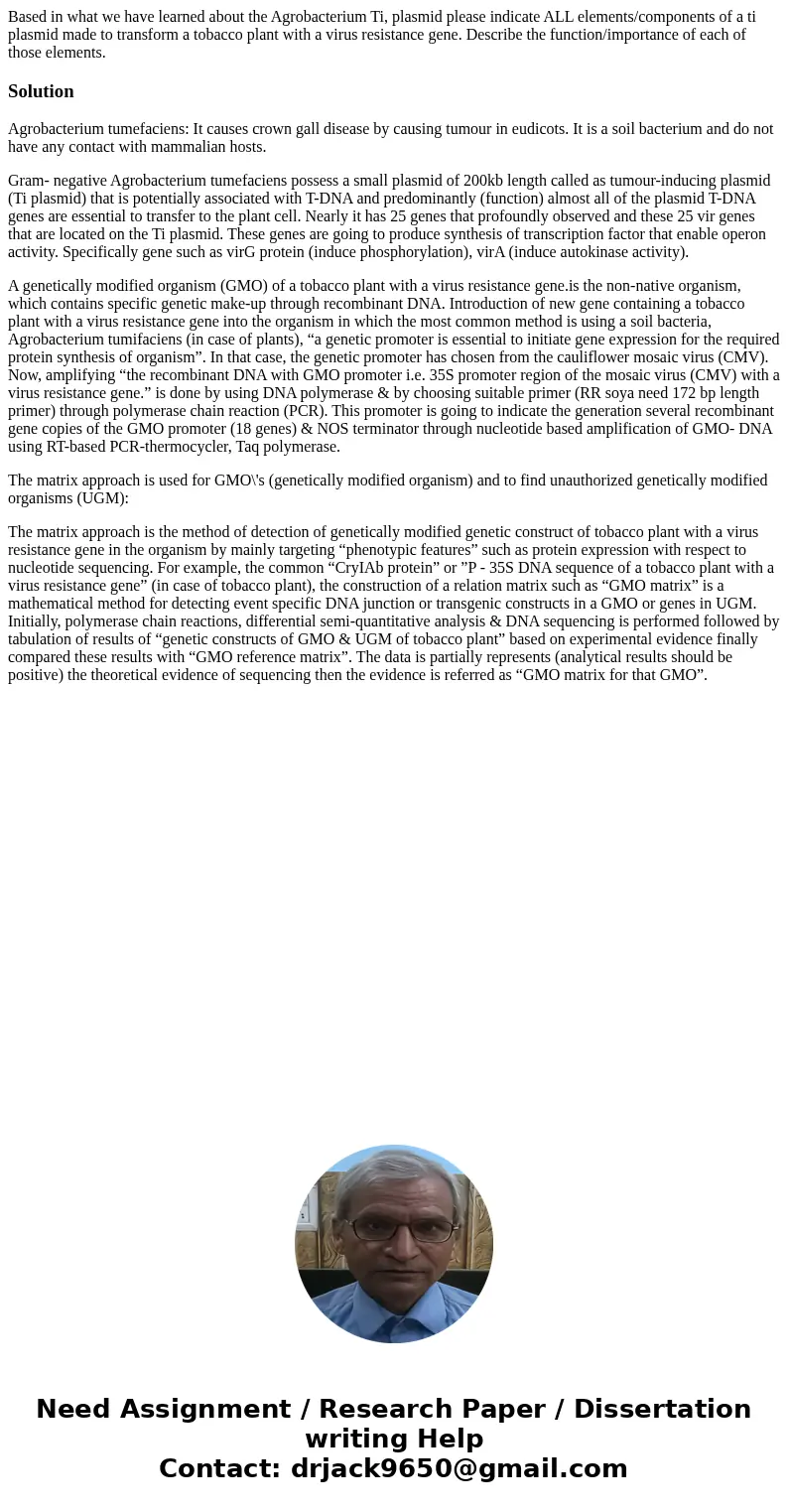Based in what we have learned about the Agrobacterium Ti pla
Based in what we have learned about the Agrobacterium Ti, plasmid please indicate ALL elements/components of a ti plasmid made to transform a tobacco plant with a virus resistance gene. Describe the function/importance of each of those elements.
Solution
Agrobacterium tumefaciens: It causes crown gall disease by causing tumour in eudicots. It is a soil bacterium and do not have any contact with mammalian hosts.
Gram- negative Agrobacterium tumefaciens possess a small plasmid of 200kb length called as tumour-inducing plasmid (Ti plasmid) that is potentially associated with T-DNA and predominantly (function) almost all of the plasmid T-DNA genes are essential to transfer to the plant cell. Nearly it has 25 genes that profoundly observed and these 25 vir genes that are located on the Ti plasmid. These genes are going to produce synthesis of transcription factor that enable operon activity. Specifically gene such as virG protein (induce phosphorylation), virA (induce autokinase activity).
A genetically modified organism (GMO) of a tobacco plant with a virus resistance gene.is the non-native organism, which contains specific genetic make-up through recombinant DNA. Introduction of new gene containing a tobacco plant with a virus resistance gene into the organism in which the most common method is using a soil bacteria, Agrobacterium tumifaciens (in case of plants), “a genetic promoter is essential to initiate gene expression for the required protein synthesis of organism”. In that case, the genetic promoter has chosen from the cauliflower mosaic virus (CMV). Now, amplifying “the recombinant DNA with GMO promoter i.e. 35S promoter region of the mosaic virus (CMV) with a virus resistance gene.” is done by using DNA polymerase & by choosing suitable primer (RR soya need 172 bp length primer) through polymerase chain reaction (PCR). This promoter is going to indicate the generation several recombinant gene copies of the GMO promoter (18 genes) & NOS terminator through nucleotide based amplification of GMO- DNA using RT-based PCR-thermocycler, Taq polymerase.
The matrix approach is used for GMO\'s (genetically modified organism) and to find unauthorized genetically modified organisms (UGM):
The matrix approach is the method of detection of genetically modified genetic construct of tobacco plant with a virus resistance gene in the organism by mainly targeting “phenotypic features” such as protein expression with respect to nucleotide sequencing. For example, the common “CryIAb protein” or ”P - 35S DNA sequence of a tobacco plant with a virus resistance gene” (in case of tobacco plant), the construction of a relation matrix such as “GMO matrix” is a mathematical method for detecting event specific DNA junction or transgenic constructs in a GMO or genes in UGM. Initially, polymerase chain reactions, differential semi-quantitative analysis & DNA sequencing is performed followed by tabulation of results of “genetic constructs of GMO & UGM of tobacco plant” based on experimental evidence finally compared these results with “GMO reference matrix”. The data is partially represents (analytical results should be positive) the theoretical evidence of sequencing then the evidence is referred as “GMO matrix for that GMO”.

 Homework Sourse
Homework Sourse